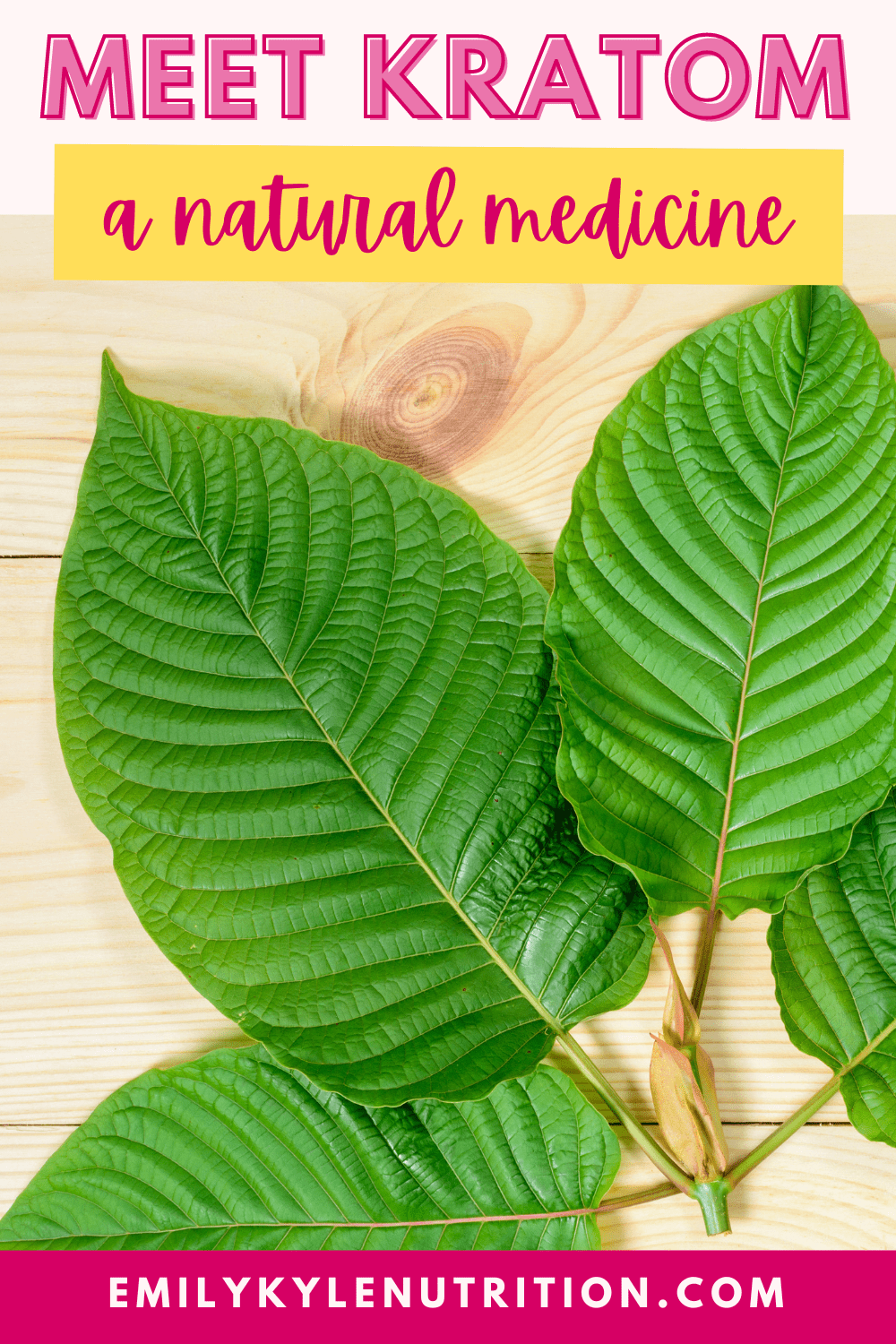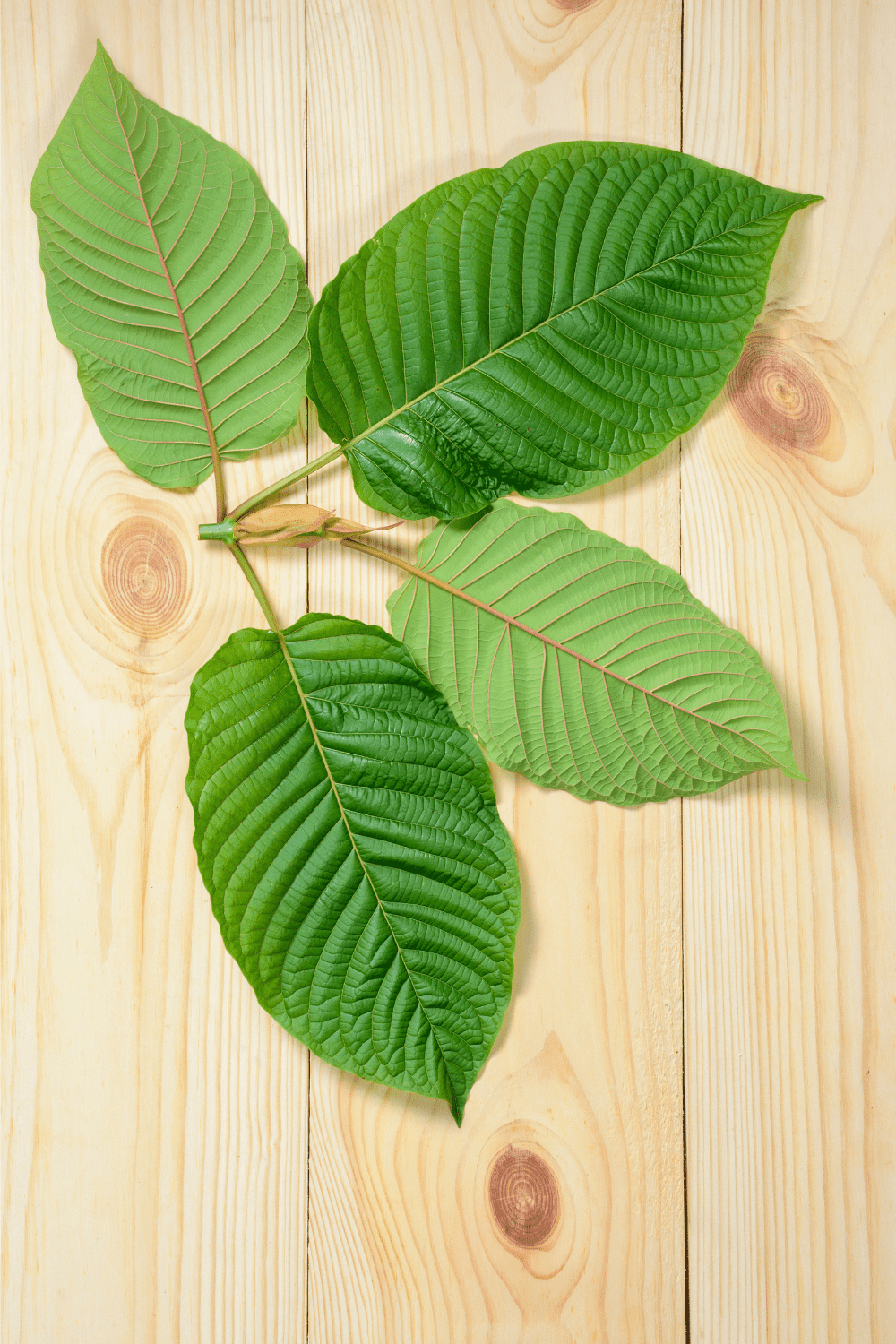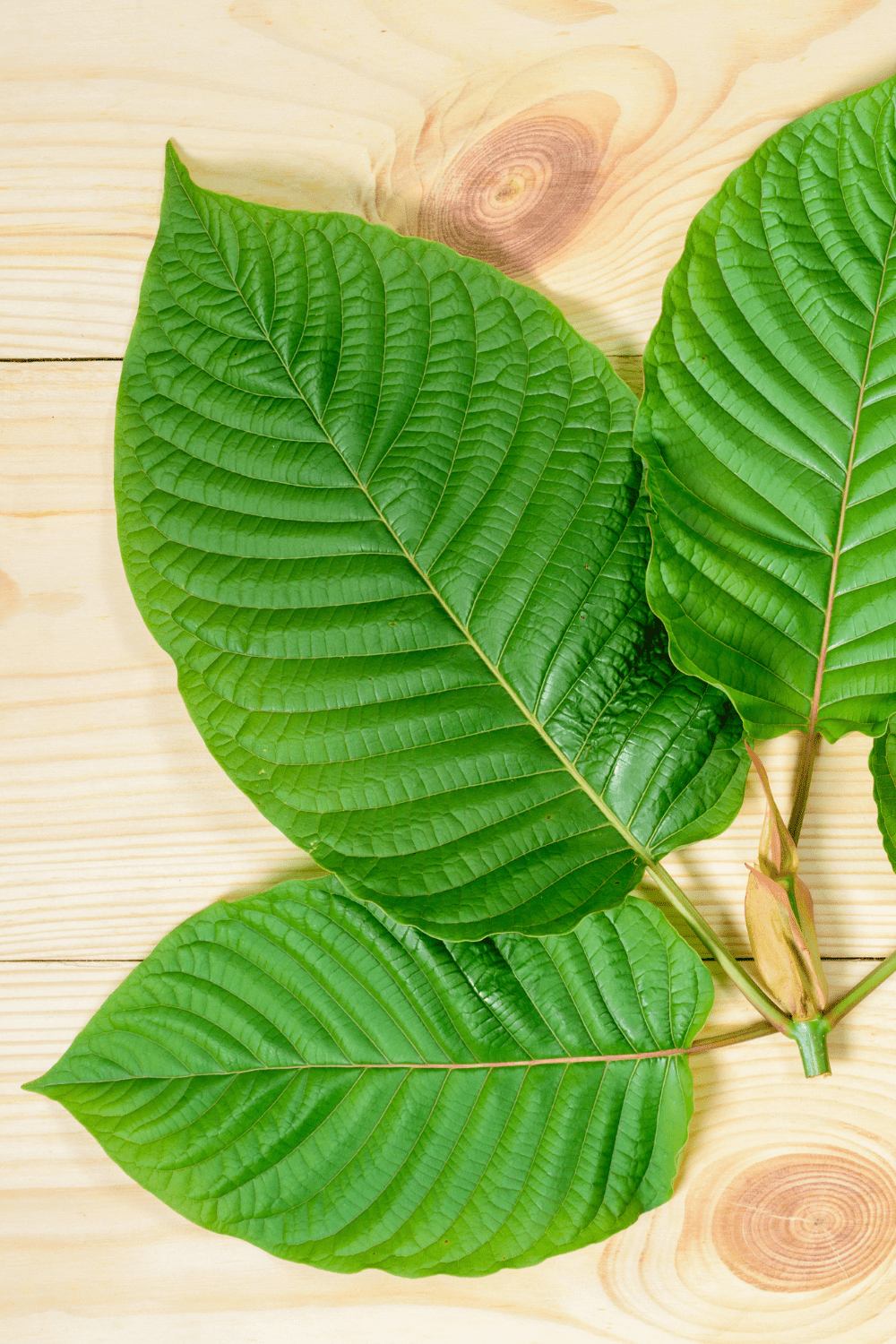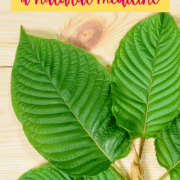Learn more about kratom, a natural tropical plant with medicinal benefits, how it can help you find pain relief and relaxation, and how to use it safely and responsibly.

Table of Contents
- Features
- Why You Will Love This Guide
- What is Kratom?
- What Does Kratom Help With?
- How Kratom Works in the Body
- How To Consume Kratom
- Kratom Capsules, Pills, and Tablets
- Kratom Powder
- Kratom Tea
- Kratom Shots
- Kratom Tinctures
- Inhalation
- Topicals
- How to Dose Kratom
- Kratom Side Effects
- Frequently Asked Questions
- Kratom Conclusion
Features
- Get an introduction to the kratom plant
- Learn how it interacts with your body’s opioid system
- Find where to get it and how to use it safely
Why You Will Love This Guide
Are you curious about natural, healing plants like cannabis and mushrooms that can support your health?
Have you heard of kratom from a friend and wondered if it could work for you?
Chances are, like me, you’re into plant medicine.
Mushrooms, cannabis, herbs – it is incredible what these plants can do along with a more plant-based, holistic lifestyle.
This ancient but newly popular plant medicine is making its way through convenience stores and smoke shops, advertising “pain relief, anxiety relief,” and more.
A few years ago, I remember seeing kratom products at a smoke shop and ignoring them because I thought it was just gas station garbage, like in the early days of CBD.
I didn’t realize that kratom, like cannabis, is a natural, plant-based alternative medicine that comes directly from a plant.
While kratom has been around for a long time, people are just now discovering its potential benefits and understanding that it could be a safer option than prescription drugs.
Those who have tried kratom rave about its ability to interact with our bodies’ natural opioid receptors, thus relieving pain and inducing euphoric effects.
But, like all plant medicine, there is a lack of credible research and an ongoing debate about the plant’s safety.
In this guide, I will introduce you to the kratom plant, show you how and why it is consumed, and discuss the possible side effects so you can make an informed decision if it is right for you.

What is Kratom?
Kratom is a tropical tree growing in Southeast Asia and parts of Africa. This evergreen plant is part of the coffee family.
Kratom leaves contain compounds called alkaloids that can produce intoxicating and pain-relieving effects when consumed.
Kratom has been used for thousands of years, anecdotally used to treat digestive issues, fight fatigue, boost energy levels, as a pain reliever, and as an opium substitute.
If you follow current health trends or frequent vitamin stores, you probably have already come across various kratom products.
This supplement is commonly recommended as an energy booster, for pain management, as a mood elevator, or for treating opioid withdrawal symptoms.
What Does Kratom Help With?
Millions of Americans have used kratom to manage chronic pain associated with conditions such as fibromyalgia and joint pain associated with conditions such as rheumatoid arthritis.
However, because kratom has not been extensively studied, it has not been officially recommended for medical use.
There has been a lot of controversy surrounding kratom due to the potential health risks associated with using plants like this.
Some experts believe the risks associated with using kratom are more dangerous than the potential benefits.
Other experts believe that when used responsibly, individuals can learn to safely use kratom as an alternative to potentially more harmful medications.
Unfortunately, more research needs to be done now, especially because many believe it is a better option than traditional opioid-based medications.

How Kratom Works in the Body
The active compounds in kratom are known as alkaloids, similar to cannabinoids in cannabis.
Other plant-based alkaloids include caffeine and nicotine.
Kratom has many types of alkaloids, the most common being:
- mitragynine,
- 7- hydroxymitragynine
- Payantheine
- Speciogynine
Evidence suggests that these alkaloids have pain-relieving properties; therefore, the kratom plant’s high alkaloid content makes it the perfect option for pain control.
Like cannabis, several factors can impact how a plant produces alkaloids, including the plant’s growing conditions, stress, and the harvest process.
These alkaloids work with our bodies’ natural opioid system, similar to how cannabinoids work with our endocannabinoid system.
The opioid system in the human body is made up of receptors that influence:
- pain perception
- breathing
- response to stress
- immune system function
- pleasure and addiction
- and more
An imbalance in the body’s opioid system may lead to mood issues, addictive behaviors, and chronic pain.
Like the endocannabinoid system, everyone’s opioid system is unique and will respond differently.

Save this guide 💌
How To Consume Kratom
Traditionally, fresh or dry kratom leaves have been chewed or brewed to make tea.
Today kratom can be bought from stores in powders, pills, drinks, or capsules.
There are many ways to consume kratom, and like cannabis, how you consume kratom will impact how it makes you feel.
The most common method of consumption is ingestion, where the product is eaten and processed by the digestive system.
Kratom Capsules, Pills, and Tablets
There are many different types of pre-made kratom capsules, pills, and tablets on the market today.
Many people prefer these options. They are quick, easy to consume, and relatively tasteless because they are swallowed.
Most pills and capsules have an average 30-45 minute onset time with a 2-3 hour duration.
Kratom Powder
To make kratom powder, the leaves are dried and then ground into a fine powder.
This powder can then be used in food to make kratom edibles, to make drinks, or for the outdated ‘toss and wash’ method that involves swallowing the powder inside a tissue.
Most people report that this consumption method is quick, with a 30-45 minute onset and 2-3 hour duration.
Of course, onset and duration times vary based on meals eaten, biochemistry, and your unique opioid system.
Kratom Tea
Kratom powder can be used to make tea; however, it’s important to note this will have a very earthy taste.
When consumed in tea, some people believe lemon juice may be added to help extract the alkaloids.
While optional, sugar or honey may be used in tea to help alleviate kratom’s bitter taste.
Tea may be absorbed faster, taking 10-30 minutes to kick in and lasting 2-8 hours, depending on the dose.
Kratom Shots
Like kratom tea, kratom shots involve dissolving powder into a liquid.
The small amount of liquid makes it easy to swallow the shot quickly and bypass most of the taste. This makes for quick, easy consumption.
Remember, like tea, shots can have a fast onset time and should be used by experienced users.
New to wellness shots? Try adding kratom powder to these ginger turmeric or watermelon shots.
Kratom Tinctures
Just like cannabis tinctures, kratom tinctures can be made with alcohol and used under the tongue for sublingual absorption.
You can use the same method for making the cannabis Green Dragon tincture.
This can then be used under the tongue. The sublingual method can take effect quickly, in 10-15 minutes.
Just be sure to evaporate some of the alcohol; it will burn, just like cannabis tinctures.
Inhalation
On occasion, the dried leaves are smoked, but I do not recommend this option, as there are safer alternatives for consumption.
If you want to smoke kratom, try a dry herb vaporizer instead.
Topicals
Just as cannabis can benefit the skin, opioids can also benefit the skin.
There are opioid receptors found in the skin that interact with alkaloids can control :
- pain
- temperature
- skin cells
- hair follicles
- and more
These receptors indicate that applying kratom topical products like pain creams and lotions can have many benefits.
How to Dose Kratom
Kratom works as a stimulant when taken in small doses.
People who have taken low doses of kratom report feeling more energetic, becoming more alert, and having an overall increased level of productivity.
The stimulant effects can be felt as soon as 10 minutes after consumption and can last up to one and a half hours.
At larger doses, kratom works as a sedative.
Those who take higher doses of kratom experience a state of euphoria, with the euphoric feelings lasting for as long as 6 hours.
Many people also report pain relief along with the sedative effects.
With kratom, follow the same golden rule: start low and go slow.
This means starting with a low dose and gradually increasing it as needed. As a general recommendation:
- Beginner dose: 1 gram
- Moderate dose: 2.5 grams
- High dose: 5-10 grams
Kratom Side Effects
As stated by Dr. Michele Ross, author of Kratom is Medicine, kratom is the “CBD of opioids” regarding safety.
She states the three things that determine the safety of consuming kratom are:
- How the product was made
- The health of the consumer
- How the consumer uses it
Education is the key to using kratom safely, reducing unwanted side effects, and preventing addiction.
Sourcing high-quality kratom products are essential but challenging due to gaps in marketplace regulation.
The best kratom products typically come from trustworthy companies offering affordable prices, a money-back guarantee, and excellent customer service.
With that said, commonly reported side effects of kratom are:
- a loss of appetite
- severe weight loss
- constipation
- extreme anxiety and irritability
- hallucinations
- altered mental state
- sedation
Serious problems associated with kratom overdose are:
- cardiac issues and hypertension
- liver damage
- insomnia
- seizures
- overdose
- death
Frequently Asked Questions
Kratom, or Mitragyna speciosa tree, is an evergreen tropical tree that is found in Southeast Asia and parts of Africa. Other common names for the plant are ithang (Thailand), ketum (Malaysia), and mambog (Philippines).
Unlike cannabis, kratom is better on its own. It is best to consume kratom 45 minutes before or 90 minutes after a meal.
Yes, you can smoke kratom, but that will be accompanied by the potential risks associated with smoking, such as asthma, COPD, or lung cancer.
Kratom Conclusion
There are many anecdotal benefits of taking kratom, and with additional research, kratom may have proven benefits in the future.
However, there is insufficient clinical evidence to back up the reported benefits.
Without this research, many questions remain unanswered, such as the recommended dosage, possible interactions, and adverse side effects.
Therefore, you should consider these factors before using any kratom products and seek medical advice from your healthcare professional.
For more information on this plant and how to use it in the best way possible to get the best results, visit the American Kratom Association.










I wish I could show my blood work from the last 8 years that I’ve been using kratom regularly. Since my start I’ve quit smoking, quit chewing Copenhagen. I was drinking straight whiskey a liter every three days, so I could sleep and help with my anxiety. Kratom helped me quit drinking. I’ve dropped 35 lbs, my A1C is down to 5.8 from 6.5. Its not a wonder the Big pharma wants to eliminate it from people accessing it. So they can get a patent on it, no doubt. It’s saved my alcoholic BIL life, my son’s life, helped many of my friends kick their pill habits. My wife has bad arthritis in her feet, I have osteo and have had both shoulders totally replaced, without pain killers. Just using kratom and ice packs for pain. My hips have osteo,my hands, my back. My wife and I both work full time jobs and wouldn’t be able to as comfortably as we do. Cannabis and kratom has helped this 62 year old man live a somewhat normal life.
Hello, Gary, your story is truly inspiring! It’s incredible to hear how kratom and cannabis have made such a positive impact on your life and the lives of those around you. Your journey to better health, overcoming addictions, and managing pain naturally is a testament to the power of these natural remedies. Stories like yours are why I do what I do, and it’s always encouraging to hear success stories from readers like you. Keep up the good work and continue to share your experiences. You never know who might benefit from hearing your story 💚
Hi Emily! I recently discovered this site and have found a wealth of great info here. So far I have tried the gummy recipe from MCT oil and the results were fantastic. So I recently purchased some Kratom powder. I’d love to make gummies from that. Which gummy recipe of yours would be most appropriate for the powder? Thanks in advance and thanks for everything you do!
Hi there,
I’m thrilled to hear you’ve found our resources helpful and enjoyed the MCT oil gummies! 😊
When it comes to using Kratom powder, I’d suggest trying our basic gummy recipe. It’s versatile and works well with different types of powders. Just remember to stir thoroughly to ensure the kratom is evenly distributed throughout the mix.
Have fun experimenting, and don’t hesitate to reach out if you have any more questions. Happy gummy-making!
Best, Emily
I just started taking Kratom tea to help me stop smoking and not crave smoking. It is a very nice mild feeling the tea gives and I do not mind the earthy taste.
Hi Annie. Thank you for your feedback. We hope you have great success with it!